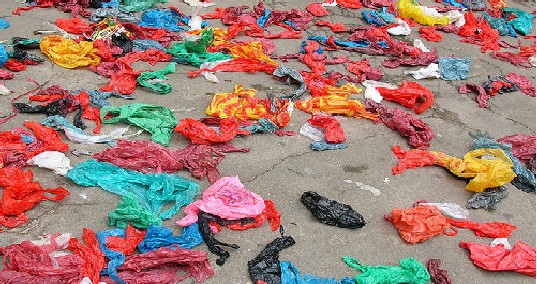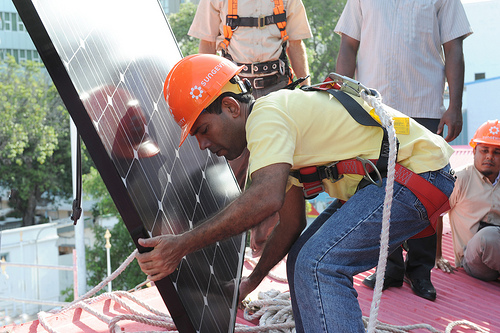 Maldives President Nasheed getting to work putting solar panels on the roof of the presidential mansion.Photo: Presidency MaldivesThe president of the Maldives, Mohamed Nasheed, didn’t just agree to have solar panels installed on the presidential mansion; he helped put them in. Nasheed scrambled up to the roof this week, screwdriver in hand, and joined the crew from California’s Sungevity, which installed the 11.5-kilowatt photovoltaic array.
Maldives President Nasheed getting to work putting solar panels on the roof of the presidential mansion.Photo: Presidency MaldivesThe president of the Maldives, Mohamed Nasheed, didn’t just agree to have solar panels installed on the presidential mansion; he helped put them in. Nasheed scrambled up to the roof this week, screwdriver in hand, and joined the crew from California’s Sungevity, which installed the 11.5-kilowatt photovoltaic array.
(Don’t expect to see Barack Obama in a hard hat any time soon, even though his administration just gave the OK to the solarization of the White House.)
The Maldives, of course, is the poster country for global warming. The Indian Ocean archipelago rests, on average, fewer than five feet above sea level and the nation of some 305,000 people would be rendered uninhabitable by rising waters.
“For the Maldives, climate change is a real challenge,” said Nasheed on a conference call Wednesday. “It’s not a problem in the future, it’s a problem we face every day.”
“We have 16 islands that have serious erosion problems,” he added. “We’ve had to relocate people from one island to another. We also have severe saltwater contamination. We have a serious food security issue.”
Sungevity and Bill McKibben’s 350.org were behind the campaign to put solar on the U.S. White House. The Maldives rooftop installation is part of this Sunday’s 10/10/10 “Global Work Party,” another McKibben initiative to get people to take action against climate change. Watch a video of the installation:
Nasheed, 43, has shown himself adept at focusing media attention on the impact of global warming on the world’s low-lying island nations — last October, he and his cabinet donned scuba gear to hold an underwater meeting.
But putting solar panels on the presidential home is not so much a PR stunt as part of the nation’s aggressive efforts to wean itself from the imported oil it relies on to generate electricity.
In January, Nasheed pledged to the United Nations that the Maldives would go carbon neutral by 2020. Making good on his pledge won’t turn back the rising tide, but Nasheed said the Maldives can show other island nations that it is possible to replace fossil fuels with renewable energy. “If it can work here in the Maldives it can work anywhere with 300,000 people,” he said. “We’re going to see a very big technology shift. There’s going to be another industrial revolution. If you’re not clever enough to embrace the future, you cannot be a world leader.”
According to an official in the president’s office, the Maldives total electricity demand is 200 megawatts.
A Finnish company, WinWind, has proposed building a 25-megawatt wind farm on the Maldives’ Gaaf Alif atoll, while Indian wind turbine maker Suzlon is investigating the feasibility of constructing a 15-megawatt wind farm on the Addu atoll. Japan has provided financial assistance for a project to install a megawatt’s worth of rooftop arrays on schools and government buildings in Male, the country’s capital.
International donors, meanwhile, have promised $30 million for renewable projects. Scotland and the Maldives have signed an agreement to investigate the potential for developing wave and tidal power in the archipelago, according to the president’s office.
To provide electricity when there’s no wind or sun, the Maldives is considering biomass power plants that would run on coconut husks. Outlying islands, however, would probably have to continue burning oil until the price of batteries used to store renewable energy became affordable.
LG, the Korean company, donated the panels for the presidential solar array and the inverters were contributed by the German company Kaco. Sungevity used satellite images and its proprietary software to size and design the solar system at its Oakland, Calif., headquarters, then flew a crew to the Maldives to install it.
“We’re averting about 200 tons of C02 from the system and there’s a 27 percent return on investment,” said Danny Kennedy, Sungevity’s co-founder and a former Greenpeace activist, who traveled to the Maldives for the installation. “President Nasheed is demonstrating this is a wise and affordable investment.”
Or as Nasheed put it, “For us, it is an issue of life or death. We have been living in the middle of the Indian Ocean and have a written history that goes back 1,000 years. We cannot relocate.”
“We have to take direct action,” he continued. “As the president, it’s difficult for me to talk like this. This has to involve a fair amount of direct action on the streets.”



